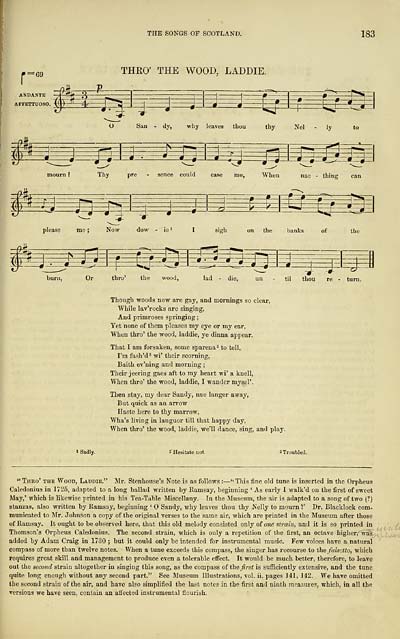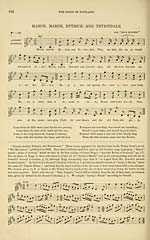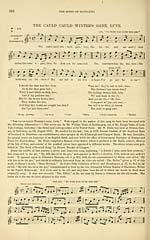Glen Collection of printed music > Printed music > Wood's edition of the songs of Scotland
(207) Page 183 - Thro' the wood, laddie
Download files
Complete book:
Individual page:
Thumbnail gallery: Grid view | List view

THE SONGS OF SCOTLAND.
183
r
; C9
THRO' THE WOOD, LADDIE.
ANDANTE
AFFETTUOSO.
fcrf
:«=*
£^=|
San - dy, why leaves thou thy Nel - iy to
m=^m^£m
please me ; Now dow - ie '
sigh
on the banks
£ES
the
m^m
burn,
§§g=2^
lad - die, un
^m
til thou re - turn.
Though woods now are gay, and mornings so clear,
While lav'rocks are singing,
And primroses springing ;
Yet none of them pleases my eye or my ear,
When thro' the wood, laddie, ye dinna appear.
That I am forsaken, some sparena 2 to tell,
I'm fash'd 3 wi' their scorning,
Baith ev'ning and morning ;
Their jeering gaes aft to my heart wi' a knell,
When thro' the wood, laddie, I wander mysel'.
Then stay, my dear Sandy, nae langer away,
But quick as an arrow
Haste here to thy marrow,
Wha's living in languor till that happy day,
When thro' the wood, laddie, we'll dance, sing, and play.
' Sadly.
2 Hesitate not.
•Troubled.
" Thro' tke Wood, Laddie." Mr. Stenhouse's Note is as follows : — "This fine old tune is inserted in the Orpheus
Caledonius in 1725, adapted to a long ballad written by Ramsay, beginning ' As early I walk'd on the first of sweet
May,' which is likewise printed in his Tea-Table Miscellany. In the Museum, the air is adapted to a song of two (?)
stanzas, also written by Ramsay, beginning ' Sandy, why leaves thou thy Nelly to mourn V Dr. Blacklock com-
municated to Mr. Johnson a copy of the original verses to the same air, which are printed in the Museum after those
of Ramsay. It ought to be observed here, that this old melody consisted only of one strain, and it is so printed in
Thomson's Orpheus Caledonius. The second strain, which is only a repetition of the first, an octave higher,- was
added by Adam Craig in 1730 ; but it could only be intended for instrumental music. Few voices have a natural
compass of more than twelve notes. When a tune exceeds this compass, the singer has recourse to the falsetto, which
requires great skill and management to produce even a tolerable effect. It would be much better, therefore, to leave
out the second strain altogether in singing this song, os the compass of the first is sufficiently extensive, and the tune
quite long enough without any second part." See Museum Illustrations, vol. ii. pages 141, 142. We have omitted
the second strain of the air, and have also simplified the last notes in the first and ninth measures, which, in all the
versions we have seen, contain an affected instrumental flourish.
183
r
; C9
THRO' THE WOOD, LADDIE.
ANDANTE
AFFETTUOSO.
fcrf
:«=*
£^=|
San - dy, why leaves thou thy Nel - iy to
m=^m^£m
please me ; Now dow - ie '
sigh
on the banks
£ES
the
m^m
burn,
§§g=2^
lad - die, un
^m
til thou re - turn.
Though woods now are gay, and mornings so clear,
While lav'rocks are singing,
And primroses springing ;
Yet none of them pleases my eye or my ear,
When thro' the wood, laddie, ye dinna appear.
That I am forsaken, some sparena 2 to tell,
I'm fash'd 3 wi' their scorning,
Baith ev'ning and morning ;
Their jeering gaes aft to my heart wi' a knell,
When thro' the wood, laddie, I wander mysel'.
Then stay, my dear Sandy, nae langer away,
But quick as an arrow
Haste here to thy marrow,
Wha's living in languor till that happy day,
When thro' the wood, laddie, we'll dance, sing, and play.
' Sadly.
2 Hesitate not.
•Troubled.
" Thro' tke Wood, Laddie." Mr. Stenhouse's Note is as follows : — "This fine old tune is inserted in the Orpheus
Caledonius in 1725, adapted to a long ballad written by Ramsay, beginning ' As early I walk'd on the first of sweet
May,' which is likewise printed in his Tea-Table Miscellany. In the Museum, the air is adapted to a song of two (?)
stanzas, also written by Ramsay, beginning ' Sandy, why leaves thou thy Nelly to mourn V Dr. Blacklock com-
municated to Mr. Johnson a copy of the original verses to the same air, which are printed in the Museum after those
of Ramsay. It ought to be observed here, that this old melody consisted only of one strain, and it is so printed in
Thomson's Orpheus Caledonius. The second strain, which is only a repetition of the first, an octave higher,- was
added by Adam Craig in 1730 ; but it could only be intended for instrumental music. Few voices have a natural
compass of more than twelve notes. When a tune exceeds this compass, the singer has recourse to the falsetto, which
requires great skill and management to produce even a tolerable effect. It would be much better, therefore, to leave
out the second strain altogether in singing this song, os the compass of the first is sufficiently extensive, and the tune
quite long enough without any second part." See Museum Illustrations, vol. ii. pages 141, 142. We have omitted
the second strain of the air, and have also simplified the last notes in the first and ninth measures, which, in all the
versions we have seen, contain an affected instrumental flourish.
Set display mode to: Large image | Transcription
Images and transcriptions on this page, including medium image downloads, may be used under the Creative Commons Attribution 4.0 International Licence unless otherwise stated. ![]()
| Special collections of printed music > Glen Collection of printed music > Printed music > Wood's edition of the songs of Scotland > (207) Page 183 - Thro' the wood, laddie |
|---|
| Permanent URL | https://digital.nls.uk/91340227 |
|---|
| Description | Scottish songs and music of the 18th and early 19th centuries, including music for the Highland bagpipe. These are selected items from the collection of John Glen (1833 to 1904). Also includes a few manuscripts, some treatises, and other books on the subject. |
|---|
| Description | The Glen Collection and the Inglis Collection represent mainly 18th and 19th century Scottish music, including Scottish songs. The collections of Berlioz and Verdi collected by bibliographer Cecil Hopkinson contain contemporary and later editions of the works of the two composers Berlioz and Verdi. |
|---|

